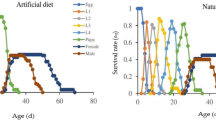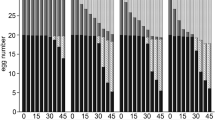Abstract
A germ-free rearing system is a crucial method for host–microbiota interactions using Nasonia as a model system. The previous rearing media in 2012 introduced toxic factors like bleach and antibiotics, required significant effort and volume of media preparation, and the rearing protocols in 2012 and 2016 often resulted in embryos, larvae, and enclosing pupae drowning, underfed, or desiccating. In this work, we optimize the germ-free rearing media that excludes the toxic factors and provide a substrate for the developing animals to have constant access to media without the risk of drowning or desiccation. The new process resulted in an increase in full maturation of larvae to adults from 33 to 65%, with no effect on the rate of growth or final adult size. This significantly improves the applicability of germ-free rearing of Nasonia and potentially other parasitoids.
Similar content being viewed by others
Introduction
The hymenopteran parasitoid, genus Nasonia, is a well-established genetic model for research in evolution, behavior, development, and endosymbiosis1. The germ-free rearing (GFR) approach2,3 makes Nasonia a versatile animal model for host-microbiota interaction4,5,6 as well. However, the previous Nasonia Rearing Media (NRM) techniques introduced potential toxic factors like bleach, antibiotics, and/or Drosophila medium to the media. What is more, both embryos and pupating larvae are susceptible to drowning at the bottom of the rearing plate, leading to a 35% survival rate from larvae to adults2,3. Here we developed an efficient Nasonia Rearing Media version 3 (NRMv3) and an optimized germ-free rearing version 2 (GFRv2) protocol.
Materials and methods
Nasonia rearing and embryo collection
The N. vitripennis strain AsymCX(u) (Wolbachia free)7 was used. All wasps were reared in fly vials with Sarcophaga bullata pupae (fly pupae) from Carolina Biological Supply (Burlington, NC) in a 25 °C incubator with constant light. Each fly vial contained 50 female and 15 male wasps with 25 fresh fly pupae. After they were incubated together for 12–24 h, we opened the fly pupae carefully, removing the puparium, and collected the wasp embryos.
Comparative analysis of development
For the conventional rearing (CV) and NRMv3 with GFRv2 rearing wasp, we collected the 1-day-old female adult and compared their body weight. As the wasp is very small (~ 1.2 mm × 0.4 mm), we observed the mass of the empty 1.5 ml tube and then calculated the difference after putting one female wasp into the tube to calculate the female wasp body weight.
Survival proportion statistics
We counted the embryo number when we transferred them to the filter (d 1).
We counted the number of dead larvae and pupae remaining on d 20 and calculated the survival rate from larvae to adulthood for each well following the approach from Shropshire et al.3:
Results and discussion
Nasonia rearing media version 3 (NRMv3)
We improved the NRMv3 (Table 1) by modifying a large volume syringe with multiple holes to crush the fly pupae, increasing the fly pupae extract amount by around 10% volume, and decreasing the amount of time spent filtering (Fig. 1). This system works more like an apple press instead of blending and juicing the pupae. We also switched to adding 50% Phosphate Buffered Saline (PBS) by volume instead of Schneider's Drosophila medium to the protein extract to exclude the potential unknown effect for wasp development.
Optimized germ-free rearing (GFRv2)
We improved the GFRv2 (Table 1) by switching the 3 mm pore transwell polyester membrane $2.55 per each (Thincert for 24-well plate, 8.0 um pore size, translucent, $122.33 for 48/case from USA Scientific, Part Number 5666-2638Q) to 100 um polypropylene filter $0.046 per each (Polypropylene Mesh Sheet, Opaque White, 12″ Width, 24″ Length, 105 microns Mesh Size, 25% Open Area, $25.17 per case which can make 550, 1.4-cm diameter filter from Amazon, Part Number CMP-0105-D) (Fig. 2), which can sharply decrease the cost. In this way, each well only needs 50 μl fresh media instead of 250 μl (GFRv1) each day so we can save 80% of the media. The previous GFRv1 protocol continued feeding the wasps with NRM for 11 days to yellow pupae so that some pupae died in the wet well environment. We continue feeding for only 8 days to avoid introducing NRMv3 when they are in the white pupae stage and are no longer feeding, thus reducing the dead proportion of white pupae.
Increased survival for larvae to adult
We compared the 1-day-old female body weights between conventional rearing (Wasps were parasitized into S. bullata pupae and developed in normal incubator) and optimized NRMv3, and with rearing protocol GFRv2, there are no significant differences (Fig. 3A). The survival rates from larvae to adult using NRMv12 and NRMv23 using GFRv1 were very low—around 25% and 35%, respectively. The optimized NRMv3 with rearing protocol GFRv2 significantly increased the survival rate by approximately 65% (Fig. 3B). Herein, the media NRMv3 with new rearing protocol GFRv2 is a more efficient and cost-effective way for Nasonia germ-free rearing.
Survival and size of Nasonia germ-free adult females. (A) One-day-old and germ-free females reared on NRMv3 with GFRv2, and females reared conventionally. Body-weight was not significantly different between germ-free and conventional rearing (Mann–Whitney U test, p > 0.05). Vertical bars with caps represent the standard deviation from the mean. (B) The proportion of larval to adult survival in the chamber.
References
Muers, M. Nasonia tools up. Nat. Rev. Genet. 11, 170. https://doi.org/10.1038/nrg2759 (2010).
Brucker, R. M. & Bordenstein, S. R. In vitro cultivation of the hymenoptera genetic model, Nasonia. PLoS One 7, e51269. https://doi.org/10.1371/journal.pone.0051269 (2012).
Shropshire, J. D., van Opstal, E. J. & Bordenstein, S. R. An optimized approach to germ-free rearing in the jewel wasp Nasonia. PeerJ 4, e2316. https://doi.org/10.7717/peerj.2316 (2016).
Wang, G.-H. et al. Changes in microbiome confer multigenerational host resistance after sub-toxic pesticide exposure. Cell Host Microbe 27, 213-224.e217. https://doi.org/10.1016/j.chom.2020.01.009 (2020).
Wang, G.-H., Dittmer, J., Douglas, B., Huang, L. & Brucker, R. M. Coadaptation between host genome and microbiome under long-term xenobiotic-induced selection. Sci. Adv. 7, 4473. https://doi.org/10.1126/sciadv.abd4473 (2021).
Brucker, R. M. & Bordenstein, S. R. The hologenomic basis of speciation: Gut bacteria cause hybrid lethality in the genus Nasonia. Science 341, 667–669. https://doi.org/10.1126/science.1240659 (2013).
Werren, J. H. et al. Functional and evolutionary insights from the genomes of three parasitoid Nasonia species. Science 327, 343–348. https://doi.org/10.1126/science.1178028 (2010).
Werren, J. H. & Loehlin, D. W. The parasitoid wasp Nasonia: An emerging model system with haploid male genetics. Cold Spring Harb. Protoc. https://doi.org/10.1101/pdb.emo134 (2009).
Funding
This work was supported by the Rowland Institute at Harvard Fellowship awarded to RMB. G.H.W. is supported by the Strategic Priority Research Program of the Chinese Academy of Sciences (Grant no. XDPB16) and the State Key Laboratory of Integrated Management of Pest Insects and Rodents (Grant no. IPM2117).
Author information
Authors and Affiliations
Contributions
G.H.W. and R.M.B. conceived the study. G.H.W. performed experiments, analyzed the data, drafted, and revised the manuscript. R.M.B. revised the manuscript and assisted with data visualization.
Corresponding authors
Ethics declarations
Competing interests
The authors declare no competing interests.
Additional information
Publisher's note
Springer Nature remains neutral with regard to jurisdictional claims in published maps and institutional affiliations.
Rights and permissions
Open Access This article is licensed under a Creative Commons Attribution 4.0 International License, which permits use, sharing, adaptation, distribution and reproduction in any medium or format, as long as you give appropriate credit to the original author(s) and the source, provide a link to the Creative Commons licence, and indicate if changes were made. The images or other third party material in this article are included in the article's Creative Commons licence, unless indicated otherwise in a credit line to the material. If material is not included in the article's Creative Commons licence and your intended use is not permitted by statutory regulation or exceeds the permitted use, you will need to obtain permission directly from the copyright holder. To view a copy of this licence, visit http://creativecommons.org/licenses/by/4.0/.
About this article
Cite this article
Wang, GH., Brucker, R.M. An optimized method for Nasonia germ-free rearing. Sci Rep 12, 219 (2022). https://doi.org/10.1038/s41598-021-04363-9
Received:
Accepted:
Published:
DOI: https://doi.org/10.1038/s41598-021-04363-9
Comments
By submitting a comment you agree to abide by our Terms and Community Guidelines. If you find something abusive or that does not comply with our terms or guidelines please flag it as inappropriate.






